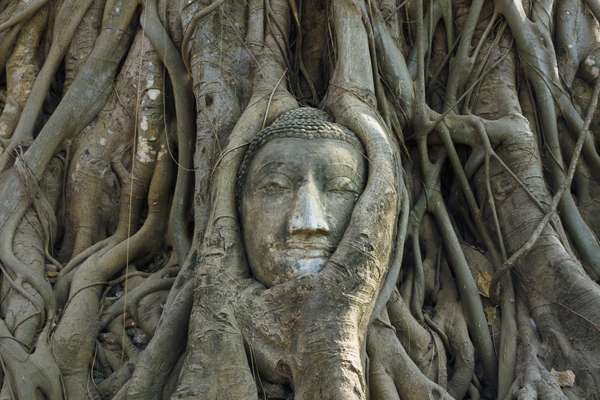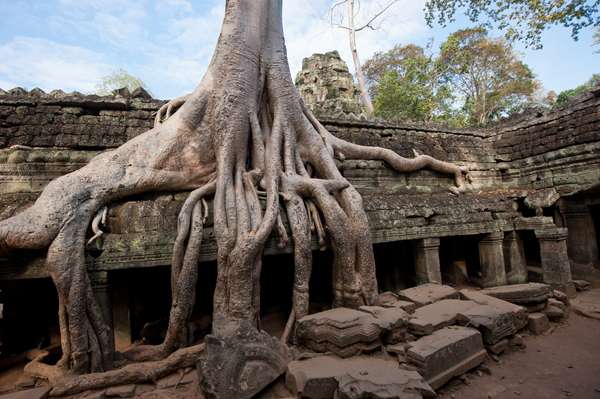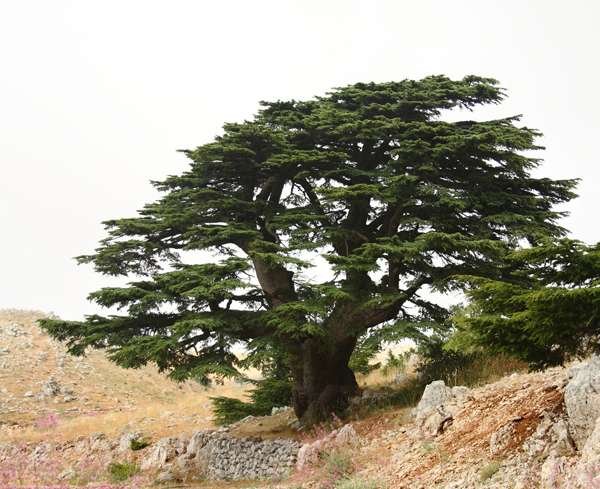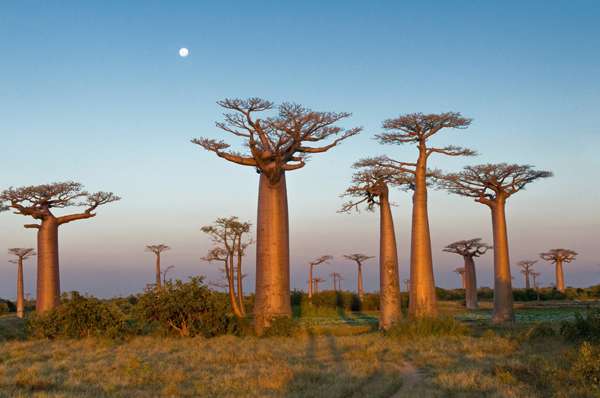The significance of trees to Mother Earth and to us humans is immeasurable. Since the dawn of time, these majestic living organisms have been a strong feature in folktales, history, paintings, and other forms of culture and art. Their awe-inspiring shapes and strength — sometimes daunting — can invoke a powerful sense of spirituality. For centuries, civilizations have praised trees as a symbol of worship, celebration, and death; some rituals persist today. Based on aesthetic or religious significance, the following list of 10 sacred trees is meant to acclaim the spiritual relationship between humans and trees.
10. Willow Tree
 Image credit: Tshooter/shutterstock
Image credit: Tshooter/shutterstock
Willow trees from the genus Salix come in all sorts of varieties and shapes. Most species of this tree thrive in riparian landscapes. A willow’s presence near water can be haunting. In Japanese tradition, it is believed that wherever a willow is present, a ghost will appear. Due to the association with the movement of the water to the moon, willows are also considered sacred in witchcraft. Priestesses of the Goddess Hecate of the Moon use willow water in their magic.
9. Ash
 Image credit Smileus/shutterstock
Image credit Smileus/shutterstock
There are records of several trees of mythical importance to the Celts, including oak, apple, birch, and ash. The latter has a connection to the order of the bards, ovates, and druids (Celtic priests). The ash tree (scientific name: Fraxinus) is mainly associated with healing and enchantment, and in particular to the Welsh magician/god Gwyddion, who had an ash wand. The tree is also similarly associated in Norse mythology to the god Odin.
8. Sacred Oak
 Image credit: Dudarev Mikhail/shutterstock
Image credit: Dudarev Mikhail/shutterstock
Believed to be the largest yellow oak (scientific name: Quercus muhlenbergii) in the United States, this iconic tree located in Oley, Pa., dates back almost 500 years. The tree received its “sacred” attribution due to a native Indian legend that claims that the tree possesses the power to heal. This sacred tree was looked upon as the shrine tree of the Delaware Indians, who prayed for it whenever they needed help.
7. Italian Cypress
 Image credit: Zoom Team/shutterstock
Image credit: Zoom Team/shutterstock
Known as “The Mournful Tree”, the Italian cypress (scientific name: Cupressus sempervirens) has been associated with death and mourning for the past 2,000 years. Planted in Islamic and European cemeteries, the tree’s legend goes back to ancient Greek and Roman mythology, when a man named Cyparissus accidentally killed his stag and begged the gods to punish him with eternal grief. Granting his wish, the gods turned him into a cypress tree, which would forever stand and mourn the dead.
6. The Bodhi Tree
 Image credit: nuttakit/shutterstock
Image credit: nuttakit/shutterstock
The sacred fig (scientific name: Ficus religiosa) is native to Nepal, India, Pakistan, and Bangladesh. It is known as the Bodhi Tree (Sanskrit for “wisdom” or “enlightened”). It is believed that it is under this tree that Buddha gained his enlightenment. After Buddha’s death, the tree became a symbol of his presence and an object of worship. At Bodh Gaya, a new Bodhi was planted in 1881 after the original one died. Many other Buddhist temples plant this tree, as well.
5. Witch Tree
 Image credit: nikitsin.smugmug.com/shutterstock
Image credit: nikitsin.smugmug.com/shutterstock
The Little Cedar Spirit Tree, or the Witch Tree, is an ancient iconic specimen from the specie Thuja Occidentalis. This tree grows on the shore of a lake in Minnesota and is sacred among the Chippewa Indian tribe. Earliest records of this lone tree date back to 1731. From the fear of it being vandalized, the tribe has purchased the land and people are now prohibited to come near the tree. 4. Banyan Tree
Another tree that is sacred in Buddhism as well as in Hinduism is the banyan tree (scientific name: Ficus benghalensis). Native to Southeast Asia, the tree’s uniqueness lies in its aerial roots, which spread upward. eventually becoming accessory trunks. Due to this shape, the tree represents eternal life. In a song called the “Bhagavad Gita” or “Song of the Lord”, Krishna uses the banyan tree as a symbol to describe the true meaning of life to the warrior hero Arjuna. Banyan is also mentioned in the Buddhist Jataka tales.
 Image credit: Javarman/shutterstock
Image credit: Javarman/shutterstock
3. Lebanese Cedar  Image credit: Diak/shutterstock
Image credit: Diak/shutterstock
Ever since the Phoenician times, this tree has attained an economic significance due to the preciousness and power of its wood, as well as a symbolic one due to its ability to age for thousands of years and withstand a snowy, mountainous climate. The Lebanese cedar (scientific name: Cedrus libani) does not only hold a religious Christian significance — it is mentioned in the bible 75 times — but is also a symbol of national pride, as it is the national emblem of Lebanon.
2. Baobab Tree
 Image credit: Nazzu/shutterstock Native to India and the African Savannas, the baobab (scientific name: Adansonia digitata) is a national emblem of Madagascar. Due to its massive size, fascinating shape, and long aging (around 3,000 years), people believe the baobab holds the spirits of the dead, and that is why it is sacred in African culture. Throughout history, kings have organized their meetings under this tree, believing that it holds magical properties that could aid them in making wise decisions.
Image credit: Nazzu/shutterstock Native to India and the African Savannas, the baobab (scientific name: Adansonia digitata) is a national emblem of Madagascar. Due to its massive size, fascinating shape, and long aging (around 3,000 years), people believe the baobab holds the spirits of the dead, and that is why it is sacred in African culture. Throughout history, kings have organized their meetings under this tree, believing that it holds magical properties that could aid them in making wise decisions.
1. Christmas Tree
 Image credit: Volodymyr Goinyk/shutterstock The most renowned sacred tree of our time is the Christmas tree. Around December, almost every Christian home and many non-Christian houses have one adorned with all sorts of lights, ornaments, and gifts. Various species of conifers can be used as a Christmas tree, such as Abis alba pyramidalis. Prior to attaining its Christian religious significance, it was known as the Yule tree (Yule is the day celebrating the coming of the winter solstice) in pagan tradition and was decorated as an outdoor live tree with hanging candles. The latter tradition still persists today in neo-pagan religions such as Wicca. Trees have always provided food, shelter, wood, shade, and many other basic life needs for human beings. It is no wonder, then, that they are worshiped or praised in every civilization. In many cultures, it is believed that hugging a tree releases negative energy from the human body. So do not forget to hug trees from time to time, and happy holidays! Article written by Dalia Zein Featured image: Image credit: Javarman/shutterstock
Image credit: Volodymyr Goinyk/shutterstock The most renowned sacred tree of our time is the Christmas tree. Around December, almost every Christian home and many non-Christian houses have one adorned with all sorts of lights, ornaments, and gifts. Various species of conifers can be used as a Christmas tree, such as Abis alba pyramidalis. Prior to attaining its Christian religious significance, it was known as the Yule tree (Yule is the day celebrating the coming of the winter solstice) in pagan tradition and was decorated as an outdoor live tree with hanging candles. The latter tradition still persists today in neo-pagan religions such as Wicca. Trees have always provided food, shelter, wood, shade, and many other basic life needs for human beings. It is no wonder, then, that they are worshiped or praised in every civilization. In many cultures, it is believed that hugging a tree releases negative energy from the human body. So do not forget to hug trees from time to time, and happy holidays! Article written by Dalia Zein Featured image: Image credit: Javarman/shutterstock












Pingback: Is There A Bird That Symbolizes Death? – Ploverbirds.com
Pingback: What Is The Meaning Of Coconut Tree Tattoo? – Erickkasysavane
Pingback: What Is A Symbol For Hope? – Almazrestaurant
Pingback: What Is The Most Sacred Tree? – Almazrestaurant
Pingback: Best Trees For The Garden